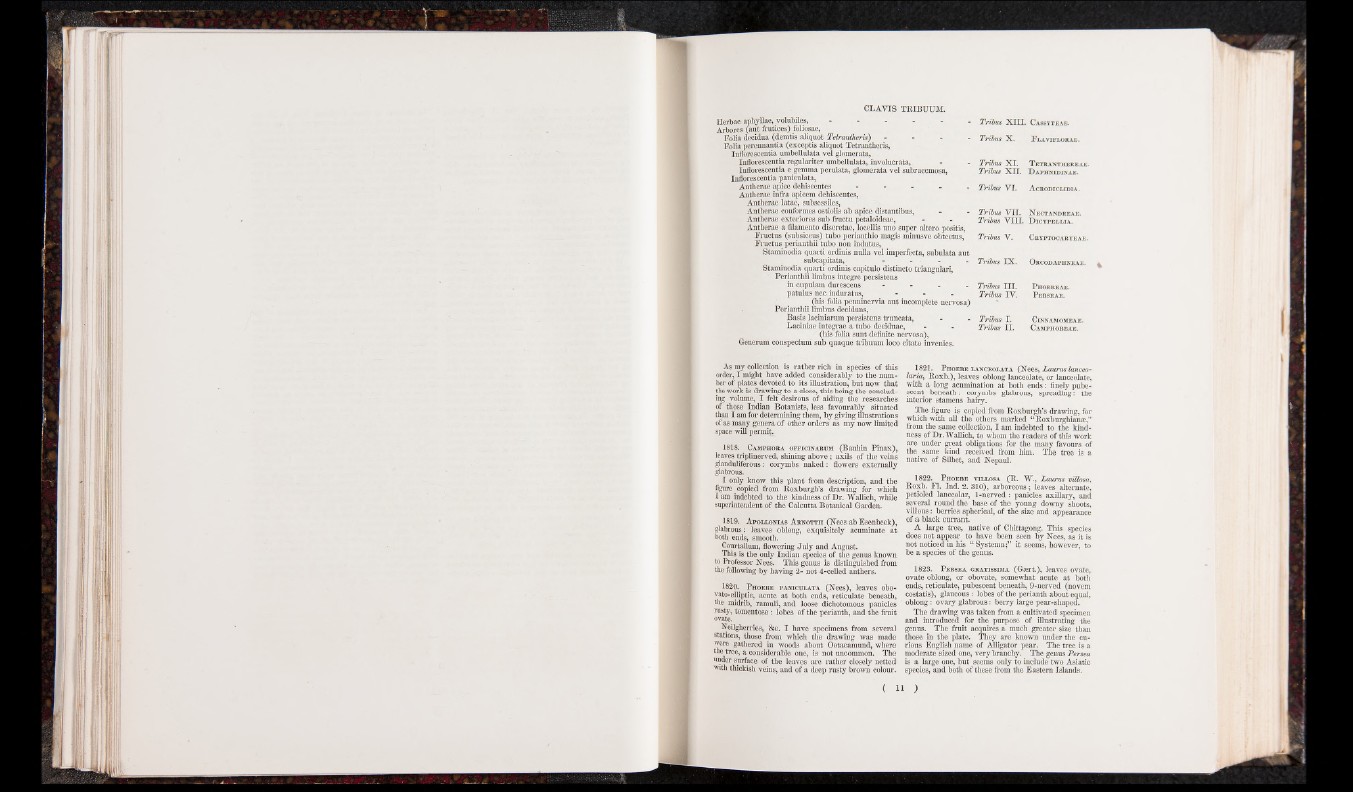
CLAVIS TRIBUUM.
Herbae aphyüae, volubiles, -
Arbores (au t frutices) foliosae,
Folia decidua (demtis aliquot Tetrantheris') -
Folia perennantia (exceptis aliquot Tetrantheris,
Inflorescentia umbellulata vel glomerata,
Inflorescentia regulariter umbellulata, involucrata,
Inflorescentia e gemma perulata, glomerata vel subraccmosa,
Inflorescentia paniculata,
Antherae apice déhiscentes -
Antherae infra apicem déhiscentes,
Antherae latae, subsessiles,
Antherae conformes ostiolis ab apice distantibus,
Antherae exteriores sub fructu petaloideae,
Antherae a filamento discretae, locellis uno super altero positis,
Fructus (subsiccus) tubo perianthio magis minusve obtectus,
Fructus perianthii tubo non indutus,
Staminodia quarti ordinis nulla vel imperfecta, subulata aut
subcapitata, ■ - . . .
Staminodia quarti ordinis capitulo distincto triangulari,
Perianthii limbus intégré persistens
.in cupulam durescens -
patulus nec induratus, . . .
(his folia penninervia aut incomplete nervosa)
Perianthii limbus deciduns,
Basis laciniarum persistens truncata,
Laciniae integrae a tubo deciduae,
(his folia sunt definite nervosa),
Generum conspectum sub quaque tribuum loco citato invenies.
Tribus X III. Cassyteae.
Tribus X. Flaviflorae.
Tribus XI.
Tribus XII.
Tetranthereae.
D aphnidinae.
Tribus VI. A crodicledia.
Tribus VU.
Tribus VIII.
N ectandreae.
D icypellia.
Tribus V. Cryptocaryeae.
Tribus IX. Orcodaphneae.
Tribus HL
Tribus IV.
Phoebeae.
Perseae.
Tribus I.
Tribus H.
ClNN AM OME A E.
Camphoreae.
As my collection is rather rich in species of this
order, I might have added considerably to the number
of plates devoted to its illustration, but now that
the work is drawing to a close, this being the concluding
volume, I felt desirous of aiding the researches
of those Indian Botanists, less favourably situated
than I am for determining them, by giving illustrations
of as many genera of other orders as my now limited
space will permit.
1818. C amphora officii?arum (Bauhin Pin ax),
leaves triplinerved, shining above; axils of the veins
glanduliferous: corymbs naked: flowers externally
glabrous.
I only know this plant from description, and the
figure copied from Roxburgh’s drawing for which
I am indebted to the kindness of Dr. Wallich, while
superintendent of the Calcutta Botanical Garden.
1819. Apollonias Arnottii (Nees ab Esenbeck),
glabrous: leaves oblong, exquisitely acuminate at
both ends, smooth.
Courtallum, flowering July and August.
This is the only Indian species of the genus known
to Professor Nees. This genus is distinguished from
the following by having 2- not 4-celled anthers.
1820. Phoebe paniculata (Nees), leaves obo-
vato-elliptic, acute at both ends, reticulate beneath,
the midrib, ramuli, and loose dichotomous panicles
rusty, tomentose: lobes of the perianth, and the fruit
ovate.
Neilgherries, &c. I have specimens from several
stations, those from which the drawing was made
were gathered in woods about Ootacamund, where
the tree, a considerable one, is not uncommon. The
under surface of the leaves are rather closely netted
with thickish veins, and of a deep rusty brown colour.
1821. Phoebe lanceolata (Nees, Lauras lanceo-
laria, Roxb.), leaves oblong lanceolate, or lanceolate,
with a long acumination at both ends: finely pubescent
beneath: corymbs glabrous, spreading: the
interior stamens hairy.
The figure is copied from Roxburgh’s drawing, for
which with all the others marked “Roxburghianse,"
from the same collection, I am indebted to the kindness
of Dr. Wallich, to whom the readers of this work
are under great obligations for the many favours of
the same kind received from him. The tree is a
native of Silhet, and Nepaul.
1822. P hoebe villosa (R. W., Lauras villosa,
Roxb. FI. Ind. 2. 310), arboreous; leaves alternate,
petioled lanceolar, 1-nerved: panicles axillary, and
several round the base of the young downy shoots,
villous: berries spherical, of the size and appearance
of a black ciirrant.
A large tree, native of Chittagong. This species
does not appear to have been seen by Nees, as it is
not noticed in his “ Systema;” it seems, however, to
be a species of the genus.
1823. P ersea gratissima (Gasrt.), leaves ovate,
ovate oblong, or obovate, somewhat acute at both
ends, reticulate, pubescent beneath, 9-nerved (novem
costatis), glaucous: lobes of the perianth about equal,
oblong: ovary glabrous: berry large pear-shaped.
The drawing was taken from a cultivated specimen
and introduced for the purpose of illustrating the
genus. The fruit acquires a much greater size than
those in the plate. They are known under the curious
English name of Alligator pear. The tree is a
moderate sized one, very branchy. The genus Persea
is a large one, but seems only to include two Asiatic
species, and both of these from the Eastern Islands.